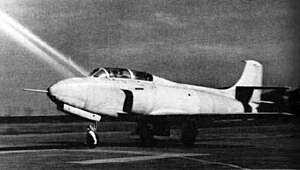Fiat G.80
| G.80/G.82 | |
|---|---|

| |
| Fiat G.80 | |
| Role | Trainer |
| Manufacturer | Fiat |
| Designer | Giuseppe Gabrielli |
| First flight | 9 December 1951 |
| Retired | 1955 |
| Primary user | Italian Air Force |
| Number built | 2 prototypes + 3 Fiat G.80 2 prototypes + 4 Fiat G.82[1] |
The Fiat G.80 was a military jet trainer developed in Italy in the 1950s, and was that country's first true jet-powered aircraft. It was a conventional low-wing monoplane with retractable tricycle undercarriage and engine air intakes on the fuselage sides. The pilot and instructor sat in tandem under a long bubble canopy.
Design and development[]
Two G.80 prototypes were followed by three preproduction machines, but the Aeronautica Militare found it unsuitable for their requirements and did not purchase it in quantity. Undeterred, Fiat developed a more refined version, dubbed the G.82, for entry in a NATO competition to select a standard jet trainer. Apart from many detail changes, the G.82 featured a longer fuselage, a Rolls-Royce Nene engine in place of the G.80's de Havilland Goblin, and wingtip tanks.
Five aircraft were constructed, but when the competition was cancelled and the G.82 was not selected by either NATO or the Aeronautica Militare, the development programme was finally terminated. Plans for specialised versions including night fighter, reconnaissance, and close-support aircraft went unrealised, as did the G.84 that was to have been powered by an Allison J35. The G.82s were used for a few years by the Aeronautica Militare's training school at Amendola before being handed over to the ("Department of Experimental Flight") in 1957.
Variants[]
- G.80-1B - prototype (two built)
- G.80-3B - pre-production version (three built)
- G.81 - definitive production version of G.80 (not built, development cancelled in favour of G.82)
- G.82 - prototypes for NATO competition (two built) and four production[1]
- G.84 - Allison J35-powered version (not built)
Operators[]
Specifications (G.82)[]

Data from Jane's All The World's Aircraft 1956–57.[2]
General characteristics
- Crew: two
- Length: 12.93 m (42 ft 5 in)
- Wingspan: 11.81 m (38 ft 9 in)
- Height: 4.08 m (13 ft 5 in)
- Wing area: 25.14 m2 (270.6 sq ft)
- Aspect ratio: 4.82:1
- Empty weight: 4,400 kg (9,700 lb)
- Gross weight: 6,250 kg (13,779 lb)
- Max takeoff weight: 7,000 kg (15,432 lb)
- Fuel capacity: 1,755 L (386 imp gal; 464 US gal) (including tip tanks)
- Powerplant: 1 × Rolls-Royce Nene 2/21 turbojet, 22 kN (5,000 lbf) thrust
Performance
- Maximum speed: 910 km/h (570 mph, 490 kn)
- Stall speed: 180 km/h (110 mph, 97 kn)
- Range: 1,600 km (990 mi, 860 nmi)
- Service ceiling: 12,500 m (41,000 ft)
- Time to altitude: 5 min 30 s to 6,000 metres (20,000 ft)
Armament
- Guns: 2× fixed, forward-firing 12.7 mm (.5 in) Colt-Browning M3 machine guns
- Rockets: 8× HVAR
- Bombs: 2× 230 kg (500 lb)
See also[]
- Vittorio Sanseverino, the test pilot who flew the aircraft on its maiden flight.
References[]
| Wikimedia Commons has media related to Fiat G.80. |
- ^ a b Official website Aeronautica Militare
- ^ Bridgman 1956, p. 173.
- Bridgman, Leonard (1956). Jane's All The World's Aircraft 1956–57. New York: The McGraw Hill Book Company.
- Taylor, Michael J. H. (1989). Jane's Encyclopedia of Aviation. London: Studio Editions. pp. 390–91.
- Italian Defence Department fact sheet[permanent dead link] (PDF format)
- Уголок неба
- Abandoned military aircraft projects of Italy
- Fiat aircraft
- 1950s Italian military trainer aircraft
- 1950s Italian fighter aircraft
- Single-engined jet aircraft
- Low-wing aircraft
- Aircraft first flown in 1951